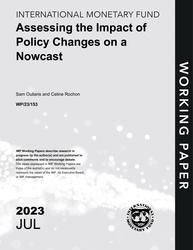
Assessing the Impact of Policy Changes on a Nowcast
Assessing the Impact of Policy Changes on a Nowcast
READ MORE...
Volume/Issue:
Volume 2023
Issue 153
Publication date: July 2023
ISBN: 9798400249716
$20.00
Add to Cart by clicking price of the language and format you'd like to purchase
Available Languages and Formats
| English |
Prices in red indicate formats that are not yet available but are forthcoming.
Topics covered in this book
This title contains information about the following subjects.
Click on a subject if you would like to see other titles with the same subjects.
Economics- Macroeconomics , Economics / General , Nowcasting , high frequency indicators , impulse responses , structural models , frequency data , Real GDP of Dominica , year-on-year percentage , baseline Nowcasting regression , USA real GDP , Oil prices , Vector autoregression , Structural vector autoregression , Global , Caribbean
Summary
Nowcasting enables policymakers to obtain forecasts of key macroeconomic indicators using higher frequency data, resulting in more timely information to guide proposed policy changes. A significant shortcoming of nowcasting estimators is their “reduced-form” nature, which means they cannot be used to assess the impact of policy changes, for example, on the baseline nowcast of real GDP. This paper outlines two separate methodologies to address this problem. The first is a partial equilibrium approach that uses an existing baseline nowcasting regression and single-equation forecasting models for the high-frequency data in that regression. The second approach uses a non-parametric structural VAR estimator recently introduced in Ouliaris and Pagan (2022) that imposes minimal identifying restrictions on the data to estimate the impact of structural shocks. Each approach is illustrated using a country-specific example.
Copyright © 2010 - 2025
Powered by:
AIDC



